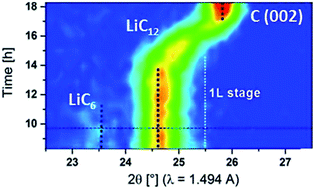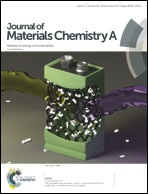Crystal structure evolution via operando neutron diffraction during long-term cycling of a customized 5 V full Li-ion cylindrical cell LiNi0.5Mn1.5O4vs. graphite†
Abstract
Disordered spinel LiNi0.5Mn1.5O4 (d-LNMO) is the cathode material of choice for next generation batteries based on 5 V systems. Unfortunately, once cycled under real conditions i.e. in a full-cell configuration (versus graphite), it displays a quite pronounced fading of the electrochemical performance, even under optimized cycling conditions, and about a half of the specific charge is ‘lost’ after 500 cycles. Thus, we intensively investigated the crystal structure evolution of a full-cell d-LNMO vs. graphite by means of operando neutron diffraction. For this purpose, a new cylindrical electrochemical cell was designed, suitable for operando neutron diffraction studies and allowing for precise Rietveld refinement analyses. During the first cycle, lithium content in the electrode materials (graphite and d-LNMO) could be determined, thus, allowing an estimation of the lithium consumption in side reactions. The neutron diffraction data obtained after long-term cycling (100 cycles) show that the fading of the electrochemical performance can be attributed to an insufficient amount of lithium in the system, which presumably is consumed by side reactions since no structural damage was observed in the positive and negative electrodes.



 Please wait while we load your content...
Please wait while we load your content...